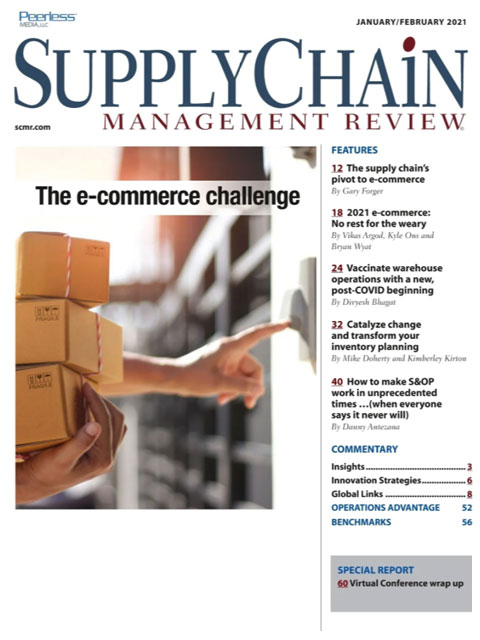Sorry, but your login has failed. Please recheck your login information and resubmit. If your subscription has expired, renew here.
January-February 2021
This morning, I turned on the television and watched the first stretch-wrapped pallets of the just-authorized vaccine being loaded onto a truck at a Pfizer plant in Michigan. From there, the pallets were headed to FedEx’s logistics hub in Memphis where they would be delivered to 153 locations across the 50 states. The event was both historic and mundane: Historic in that the shipments represent the hope of a nation that in the coming months, we’ll begin to put 2020—and COVID—in the rearview mirror; mundane in that this is a scene repeated millions of times a day, without fanfare, in plants and distribution centers across the country. Two of… Browse this issue archive.Need Help? Contact customer service 847-559-7581 More options
When I began researching oil as part of the MIT Supply Chain 2020 Project in 2005, I espoused a reduction of oil consumption in global supply chains by slowing them down and developing cost- and energy-efficient networks, in contrast to cost- and asset-efficient ones. When oil prices were high, cost reductions also translated to CO2 emission reductions. However, the position was based on two major demand-supply assumptions. While oil would be readily available into the foreseeable future: 1) its price would rise in the long run as demand for it rose with robust global economic growth; and 2) oil extraction costs would continue to rise over time because it was getting harder to extract it from the earth.
Since we have already seen 2020, we now know that both assumptions were incorrect. Or to paraphrase the words of Lawrence “Yogi” Berra, the late great New York Yankees catcher: “the future ain’t what is used to be” and “it’s [not] déjà vu all over again.”
As discussed in last year’s Insights column, “Oil Update: Fracking challenged with cheaper oil” (SCMR, Jan/Feb 2020): 1) regarding the demand for oil, we were in the “era of cheaper oil,” as well as having suffered through the Great Recession of 2008 and experiencing today’s COVID-19 virus economic woes; and 2) regarding the supply of oil, fracking techniques have lowered the time, resources and expense needed to quickly turn on and turn off oil derived from shale. Therefore, on the demand side, reducing oil consumption because of higher prices was no longer a goal, and neither was co-related energy efficiency—therefore that goal became speed-up the supply chain to enhance customer service. Also, regarding supply, the world’s energy map has been altered. The Wall Street Journal’s (WSJ) review last September of “The New Map,” a book written by oil guru Daniel Yergin, postulates there is a new energy map. It states: “...[previously] all the action went to where the oil was. Thus, the desert wastelands of the Middle East were transformed into energy hubs and their chronic internecine conflicts consumed the attention.” The author states that: “The world’s energy map is no longer an accident of geology. It has been redrawn by technological, economic and political wherewithal.”
Brief history of oil pricing

This complete article is available to subscribers only.
Log in now for full access or start your PLUS+ subscription for instant access.
SC
MR
Sorry, but your login has failed. Please recheck your login information and resubmit. If your subscription has expired, renew here.
January-February 2021
This morning, I turned on the television and watched the first stretch-wrapped pallets of the just-authorized vaccine being loaded onto a truck at a Pfizer plant in Michigan. From there, the pallets were headed to… Browse this issue archive. Access your online digital edition. Download a PDF file of the January-February 2021 issue.
When I began researching oil as part of the MIT Supply Chain 2020 Project in 2005, I espoused a reduction of oil consumption in global supply chains by slowing them down and developing cost- and energy-efficient networks, in contrast to cost- and asset-efficient ones. When oil prices were high, cost reductions also translated to CO2 emission reductions. However, the position was based on two major demand-supply assumptions. While oil would be readily available into the foreseeable future: 1) its price would rise in the long run as demand for it rose with robust global economic growth; and 2) oil extraction costs would continue to rise over time because it was getting harder to extract it from the earth.
Since we have already seen 2020, we now know that both assumptions were incorrect. Or to paraphrase the words of Lawrence “Yogi” Berra, the late great New York Yankees catcher: “the future ain’t what is used to be” and “it’s [not] déjà vu all over again.”
As discussed in last year’s Insights column, “Oil Update: Fracking challenged with cheaper oil” (SCMR, Jan/Feb 2020): 1) regarding the demand for oil, we were in the “era of cheaper oil,” as well as having suffered through the Great Recession of 2008 and experiencing today’s COVID-19 virus economic woes; and 2) regarding the supply of oil, fracking techniques have lowered the time, resources and expense needed to quickly turn on and turn off oil derived from shale. Therefore, on the demand side, reducing oil consumption because of higher prices was no longer a goal, and neither was co-related energy efficiency—therefore that goal became speed-up the supply chain to enhance customer service. Also, regarding supply, the world’s energy map has been altered. The Wall Street Journal’s (WSJ) review last September of “The New Map,” a book written by oil guru Daniel Yergin, postulates there is a new energy map. It states: “...[previously] all the action went to where the oil was. Thus, the desert wastelands of the Middle East were transformed into energy hubs and their chronic internecine conflicts consumed the attention.” The author states that: “The world’s energy map is no longer an accident of geology. It has been redrawn by technological, economic and political wherewithal.”
Brief history of oil pricing
Each annual oil update I’ve done has shown Figure 1, an updated historical chart depicting “real” quarterly imported crude oil prices since 1974. The chart shows the various pricing levels experienced. From the demand side, the first signs of “cheaper oil” appeared as a precipitous drop as a result of the Great Recession of 2008, which drastically depressed worldwide economies and the demand for oil. This was followed by a three-plus year period, termed the “$100+ plateau” before reaching cheaper oil. That plateau used to ominously loom in the rearview mirror as a reminder of what could happen if worldwide economic and supply conditions reached the robust levels seen prior to the recession.
 SUBSCRIBERS: Click here to download PDF of the full article.
SUBSCRIBERS: Click here to download PDF of the full article.
SC
MR


Latest Supply Chain News
- Despite American political environment, global geopolitical risks may be easing
- Joseph Esteves named CEO of SGS Maine Pointe
- Employees, employers hold divergent views on upskilling the workforce
- April manufacturing output slides after growing in March
- Q1 sees a solid finish with positive U.S.-bound import growth, notes S&P Global Market Intelligence
- More News
Latest Podcast

 Explore
Explore
Topics
Procurement & Sourcing News
- Despite American political environment, global geopolitical risks may be easing
- April manufacturing output slides after growing in March
- World Trade Centers offers a helping hand to create resilient, interconnected supply chains
- Bridging the ESG gap in supply chain management: From ambition to action
- Israel, Ukraine aid package to increase pressure on aerospace and defense supply chains
- How CPG brands can deliver on supplier diversity promises
- More Procurement & Sourcing
Latest Procurement & Sourcing Resources

Subscribe

Supply Chain Management Review delivers the best industry content.

Editors’ Picks






